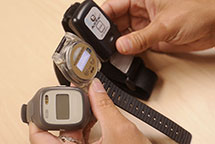 Using a motion-sensing chip built into a wristwatch-shaped device, sleep scientists can build a highly accurate map of a person’s daily cycle of sleep and wakefulness. The method is called actigraphy, and UAB investigators are using it to take the university’s sleep research program to a new place: patients’ own bedrooms.
Using a motion-sensing chip built into a wristwatch-shaped device, sleep scientists can build a highly accurate map of a person’s daily cycle of sleep and wakefulness. The method is called actigraphy, and UAB investigators are using it to take the university’s sleep research program to a new place: patients’ own bedrooms.“An overnight sleep study is the gold standard” in order to get a precise understanding of a person’s sleep issues, says Kristin Avis, Ph.D., CBSM, associate director of the Pediatric Sleep Disorders Center at Children’s of Alabama and associate professor of pediatrics at UAB. Overnight sleep studies are routinely conducted for adults at UAB Highlands Sleep Wake Disorders Center and for children at the Pediatric Sleep Disorders Center at Children’s of Alabama. “But in many cases, we would like to establish what a patient’s sleep pattern is over time, and how they sleep in their everyday environment. And we can’t do that in the clinic.”
Watch Closely
A recent grant from the UAB Health Services Foundation allowed Avis to purchase 35 actigraph “watches,” which can record a person’s sleep and wake patterns 24 hours a day, for up to 21 days. “That allows us to determine total sleep time, including a nap analysis,” Avis says. “The watches also measure light exposure, which can affect our circadian cycle of sleep.”
UAB researchers are putting the new devices to work in a host of studies. Avis is using actigraphy to evaluate the effect of sleep deprivation on children’s pedestrian injury risk. Karen Gamble, Ph.D., assistant professor in UAB Department of Psychiatry and Behavioral Neurobiology, is using actigraphy to analyze the rest patterns of shift-working nurses and the effect of shift work on their circadian rhythms. Rachel Fargason, M.D., associate professor in the psychiatry department, is using actigraphy to evaluate sleep patterns and circadian rhythms in adults with ADHD. Other collaborators plan to use actigraphy to evaluate sleep patterns in women with sleep apnea who are experiencing high-risk pregnancies and patients with Parkinson’s disease following deep-brain stimulation; to study the effect of sleep deprivation on childhood injury risk; and to investigate the link between circadian rhythms and cardiovascular disease.
No Rest for the Weary
As obesity rates climb across the United States, both adults and children are having more trouble with sleep, Avis notes. Sleep-related disorders currently affect an estimated 70 million Americans, and obstructive sleep apnea, a condition in which the airway is blocked or narrowed during sleep, is closely associated with obesity, she explains.
 Kristen Avis, Ph.D. Kristen Avis, Ph.D. |
“Obesity increases your risk of OSA fourfold, and 33 percent of American children are now obese,” Avis says. The treatment for OSA in normal-weight kids includes the removal of the tonsils and adenoids, which cures the problem in 83 percent of cases, Avis notes. “But in kids who are obese, as few as 20 percent are cured with this treatment.”
When OSA remains even after the removal of tonsils and adenoids, most of these patients wear a continuous positive airway pressure device, which keeps the airway open during sleep, Avis says. Among several other projects, Avis plans to use the actigraph watches as part of a safety study to “see how well children sleep when they’re exposed to CPAP in the first few weeks.”
One of the most useful features of the watches is their versatility, which lets them find a place in research from all over campus. “They have already helped us build collaborations between investigators in a variety of fields”—including cardiology, psychiatry, neurology, obstetrics and gynecology, and pediatrics—“and we’re hoping that will continue,” Avis says. “The National Institutes of Health has made sleep research a priority, and we would like to take a leadership role here at UAB.”